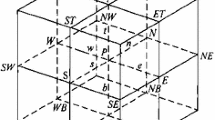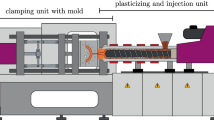Abstract
A finite element analysis system is developed to investigate the viscoelastic deformation of polymer during hot embossing process, employing a nonlinear viscoelastic model as a polymer constitutive model. The interface between air and polymer is captured by a level set method. The viscoelastic flow problem is solved using a discrete elastic-viscous stress splitting (DEVSS) formulation along with a matrix logarithm of the conformation tensor. A discontinuous Galerkin formulation is employed to treat convective problems. The developed method is applied to the filling stage of hot embossing for a two-dimensional cavity. The details of the polymer viscoelastic deformation are investigated in terms of the conformation tensor distribution at the end of the embossing. The embossing speed and the cavity aspect ratio are found to have significant effects on the polymer conformation development in the molded part. As for the difference in filling pattern between the Newtonian viscous fluid and the viscoelastic fluid, the difference grows with time, but not significant in the particular geometry and processing conditions chosen.
Similar content being viewed by others
References
Arora, A., G. Simone, G. B. Salieb-Beugelaar, J. T. Kim, and A. Manz, 2010, Latest developments in micro total analysis systems, Anal. Chem. 82 4830–4847.
Becker, H. and U. Heim, 2000, Hot embossing as a method for the fabrication of polymer high aspect ratio structures, Sensors and Actuators 83 130–135.
Fattal, R. and R. Kupferman, 2004, Constitutive laws for the matrix-logarithm of the conformation tensor, J. Non-Newtonian Fluid Mech. 123 281–285.
Fortin, M. and A. Fortin, 1989, A new approach for the FEM simulation of viscoelastic flows, J. Non-Newtonian Fluid Mech. 32 295–310.
Guénette, R. and M. Fortin, 1995, A new mixed finite element method for computing viscoelastic flows, J. Non-Newtonian Fluid Mech. 60 27–52.
Haagh, G. A. A. V. and F. N. van De Vosse, 1998, Simulation of three-dimensional polymer mould filling processes using a pseudo-concentration method, Int. J. Numer. Meth. Fluids 28 1355–1369.
He, Y., J. Z. Fu and Z. C. Chen, 2007, Research on optimization of the hot embossing process, J. Micromech. Microeng. 17 2420–2425.
Heckele, M., W. Bacher, and K. D. Müller, 1998, Hot embossing — The molding technique for plastic microstructures, Microsyst. Technol. 4 122–124.
Heckele, M. and W. K. Schomburg, 2004, Review on micro molding of thermoplastic polymers, J. Micromech. Microeng. 14 R1–R14
Hirt, C. W., A. A. Amsden, and J. L. Cook, 1997, An arbitrary lagrangian-eulerian computing method for all flow speeds, J. Comput. Phys. 135 203–216.
HSL, 2011, A collection of Fortran codes for large scale scientific computation. http://www.hsl.rl.ac.uk.
Hulsen, M. A., R. Fattal, and R. Kupferman, 2005, Flow of viscoelastic fluids past a cylinder at high Weissenberg number: Stabilized simulations using matrix logarithms, J. Non-Newtonian Fluid Mech. 127 27–39.
Juang, Y. J., J. Lee, and K. W. Koelling, 2002, Hot embossing in microfabrication. Part II: Rheological characterization and process analysis, Polym. Eng. Sci. 42 551–566.
Kang, T. G. and T. H. Kwon, 2007, Numerical investigation of hot embossing filling characteristics, Int. Polym. Process. 22 266–275.
Park, J. M., N. H. Kim, B.-K. Lee, K.-H. Lee, and T. H. Kwon, 2008, Nickel stamp fabrication and hot embossing for massproduction of micro/nano combined structures using anodic aluminum oxide, Microsyst. Technol. 14 1689–1694.
Press, W. H., S. A. Teukolsky, W. T. Vetterling, and B. P. Flannery, 1992, Numerical recipes in FORTRAN 77: the art of scientific computing, Cambridge University Press.
Sussman, M., P. Smereka, and S. Osher, 1994, A level set approach for computing solutions to incompressible two-phase flow, J. Comput. Phys. 114 146–159.
Taylor, H, Y. C. Lam, and D. Boning, 2009, A computationally simple method for simulating the micro-embossing of thermoplastic layers, J. Micromech. Microeng. 19 075007.
Worgull, M. and M. Heckele, 2004, New aspects of simulation in hot embossing, Microsyst. Technol. 10 432–437.
Worgull, M., J. F. Hétu, K. K. Kabanemi, and M. Heckele, 2006, Modeling and optimization of the hot embossing process for micro- and nanocomponent fabrication, Microsyst. Technol. 12 947–952.
Yao, D., V. L. Virupaksha, and B. Kim, 2005, Study on squeezing flow during nonisothermal embossing of polymer microstructures, Polym. Eng. Sci. 45 652–660.
Author information
Authors and Affiliations
Corresponding author
Rights and permissions
About this article
Cite this article
Park, J.M., Kang, T.G. & Park, S.J. Numerical simulation of hot embossing filling stage using a viscoelastic constitutive model. Korea-Aust. Rheol. J. 23, 139–146 (2011). https://doi.org/10.1007/s13367-011-0017-3
Received:
Revised:
Accepted:
Published:
Issue Date:
DOI: https://doi.org/10.1007/s13367-011-0017-3




